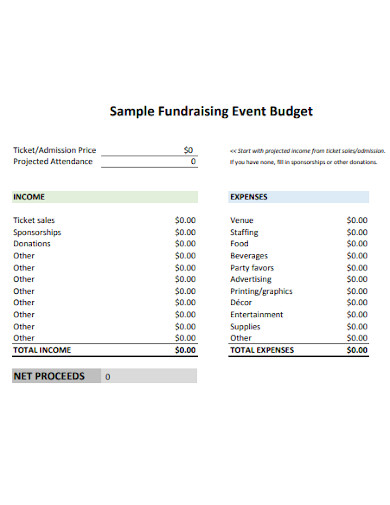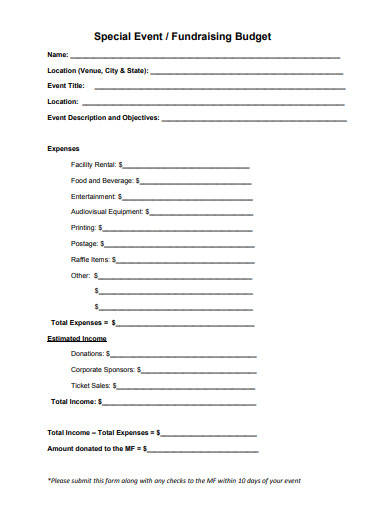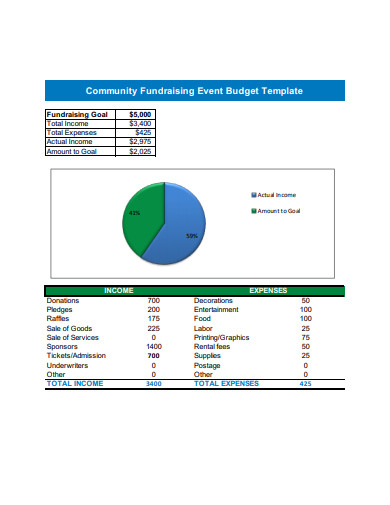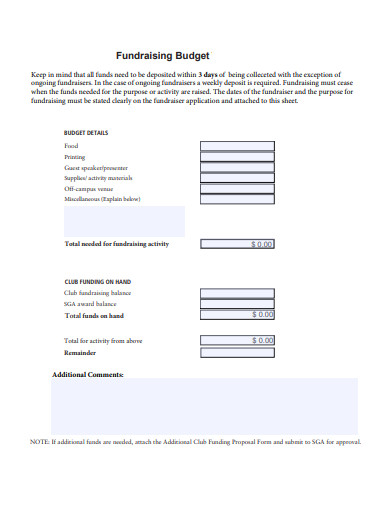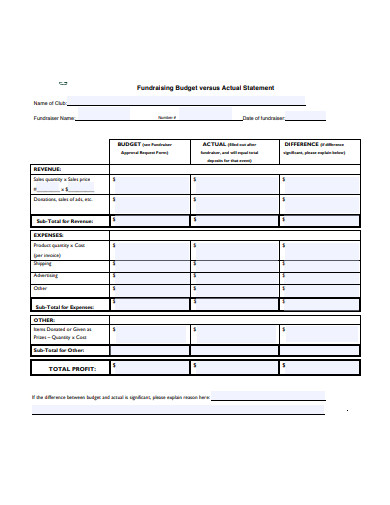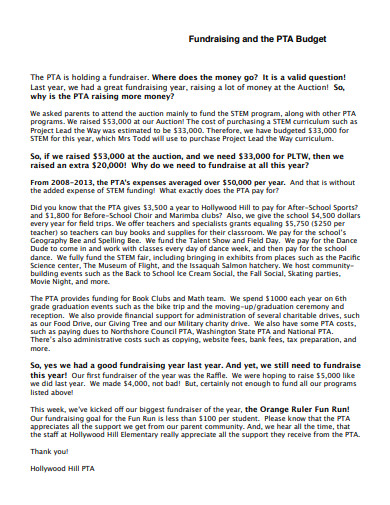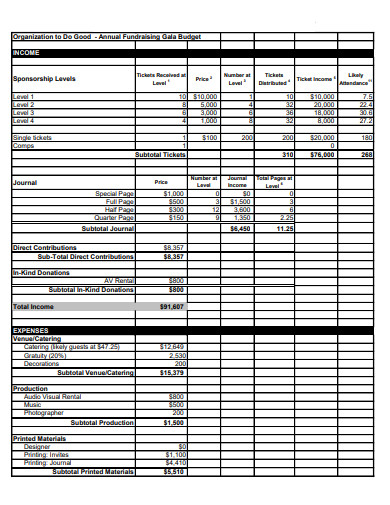Fundraising Budget Examples to Download
Nonprofit organizations have their respective department that thinks of ways to generate funds for philanthropic campaigns. Some of them consider sports events, concerts, selling goods, and some even look to gain government grants. Once successful, the said department is obligated to produce a fundraising proposal that consists of the checklist of activities, strategies, and a variety of budget paperwork. This paperwork may include the budget goal, event budget estimate, organization budget, venue budget, donation budget, and campaign budget. Below, you’ll see a bunch of these financial tracking templates that also predicts your fundraising event’s expenses. In addition, you can also learn more about these fundraiser budgets through the article we’ve prepared for you.
10+ Fundraising Budget Examples
1. Fundraising Campaign Budget
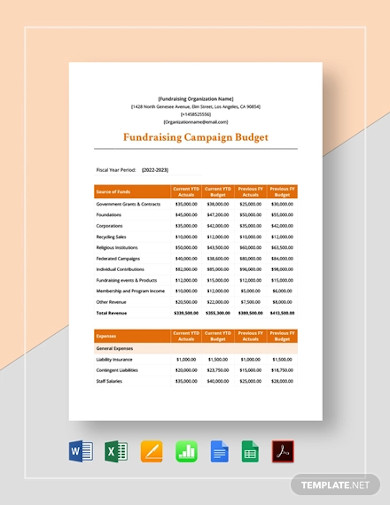
2. Fundraising Budget Example
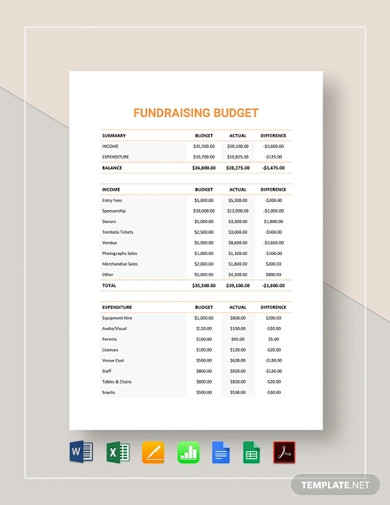
3. Fundraising Event Budget
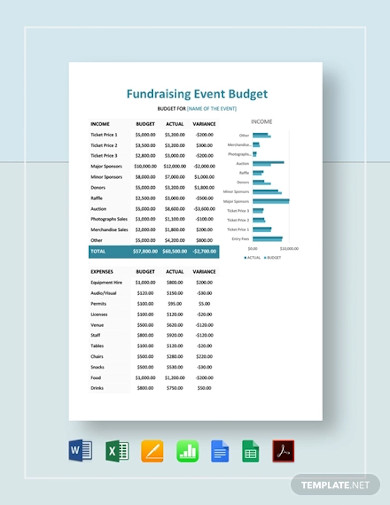
4. Sample Fundraising Event Budget
5. Fundraising Budget Form
6. Community Fundraising Event Budget
7. Fundraising Budget Worksheet
8. Nonprofit Fundraising Budget
9. Sample Fundraising Budget
10. Charity Fundraising Budget
11. Annual Fundraising Budget
What Is a Fundraising Budget?
A fundraising budget is a document that helps set up a financial expectation of a certain fundraising event. It predicts how much money the event would potentially generate while accounting how much it would cost to become successful. These forecasts are made possible through past accounting histories that are recorded in various documents, such as nonprofit financial reports, financial statements, invoices, receipts, and more. The fundraising software developer, DoJiggy, stated in one of its blogs that the incoming revenue can be obtained through product and ticket sales, as well as on sponsorships, and online donations. They are just one of the many pieces of information that such a document contains. As you continue reading, you’ll discover more about it.
Tips To Win Grants
The federal government offers grants to organizations from time to time. However, they offer them not just on ordinary organizations but to associations whose proposed undertaking is highly beneficial and with a high probability of success. This is very applicable to nonprofit proposals, business proposals, and others. So, how do you appeal to federal agencies or federal departments? Here’s some tip on how to win grants:
1. Know and meet the set of requirements
2. Read other articles about how to successfully obtain a grant and adapt what works best for you
3. Pay attention to what the agency or department wants in exchange beforehand
4. Formally expound your problem and its corresponding solution
5. Seek help from grant writing professionals
How To Create a Fundraising Budget
Considering that you’re going to handle numbers, it is obvious that making a fundraising budget is a daunting task. However, the deed has to be done for your organization to secure the financial success of your event. To help you get through that task, we offer you our very own outline of guidelines. Check them out below.
1. Decide What Fundraising Activity To Hold
The very first step in making a fundraising budget is to decide what kind of activity to organize. If you’ve discovered that your company has a product sales proposal, an exhibition proposal, or an event proposal, then you have a good idea of what activity to hold. Once you’ve decided which activity suits best your organization’s capabilities, you’ll have no problem determining other details.
2. Identify Areas to Consider
In every activity, there are a lot of things you need to consider. For example, if your organization is currently working on a food product proposal, then you have to consider the costs for the venue, labor force, and materials. Since fundraising activities aren’t permanent, the venue’s cost will most likely be in the form of a rental fee. Moreover, the labor force refers to the food makers, packers, and delivery personnel, while materials involve food ingredients, food packing items, kitchen utensils, and more.
3. Gather Expense Records
After knowing what aspects need to be put into consideration, gather all the relevant and necessary records. As mentioned above, these could be financial reports, profit and loss statements, invoices, and receipts. You can also ask for quotations from service providers and retailers.
4. Itemize Necessities
Once all the pertinent records have been collected, pick out the items that you think are important in your budgeting process. Then, categorize them according to the type of cost. There are two types of cost: fixed cost and variable cost. Fixed costs are expenses that don’t get easily affected by both internal and external factors. A good example of them is the venue’s rental fee. The variable costs, on the other, is the complete opposite. An example of this is the food ingredients that can fluctuate depending on how many are consumed.
5. Review and Finalize
Make it a habit to review your organization’s fundraising proposal before finalizing it. This will help you clear up any errors, especially in the amounts. Always bear in mind that the slightest error in the numbers will significantly damage the overall calculation. Any identified errors must be dealt with straight away. After everything is polished, submit your document to the project manager and get it approved.
FAQs
Are fundraising events effective?
For nonprofit organizations, fundraising events are good effective events that do not only help in gathering funds but also on making professional connections.
What are the different ways to measure the success of your fundraising activity?
1. Online Gift Percentage
2. Cost Per Dollar Raised (CPDR)
3. Conversion Rate
4. Return on Investment (ROI)
5. Donor Growth Rate
6. Average Gift Size
7. Donor Retention Rate
How do you calculate a fundraising event’s return on investment?
Find the difference between your total earned money and total costs. Then, divide the result to the total costs and multiply by 100. The final result is your fundraising event’s return on investment.
Just like how the famous quote by Winston Churchill goes, “We make a living by what we get, but we make life by what we give.” Fundraising events have long been proven to be very beneficial to society. They can be considered a perfect balance between getting and giving. However, just like other organizational activities, fundraising requires money to be successful. So once these financial needs are taken care of, they must be protected, tracked, and used according to their purpose. A fundraising budget is a perfect tool for that.



